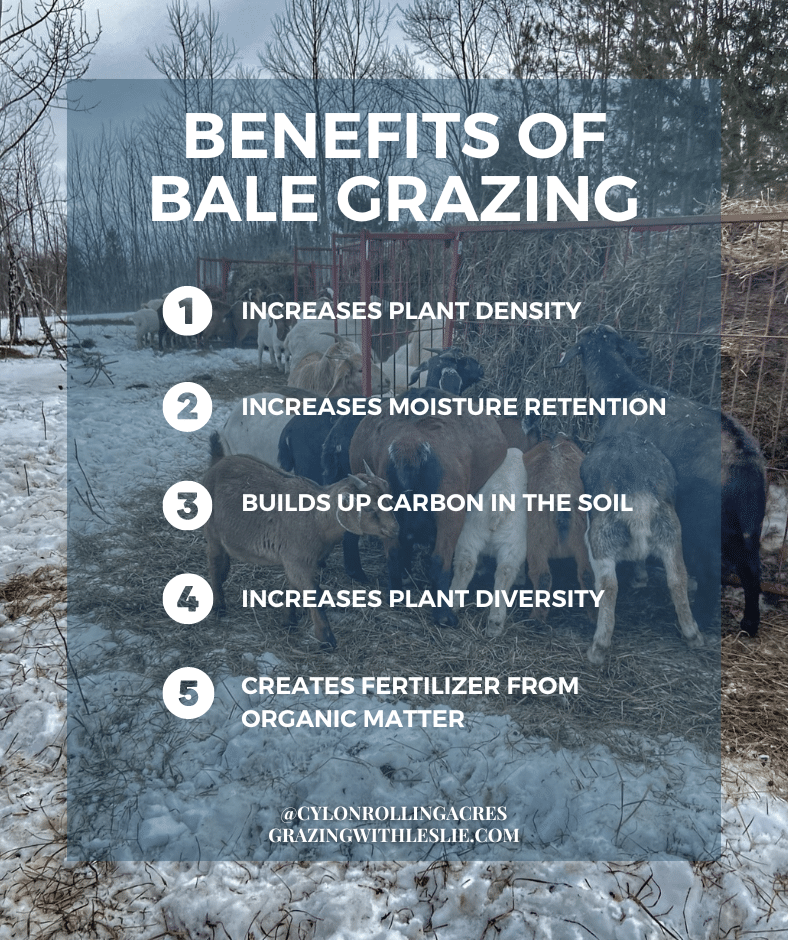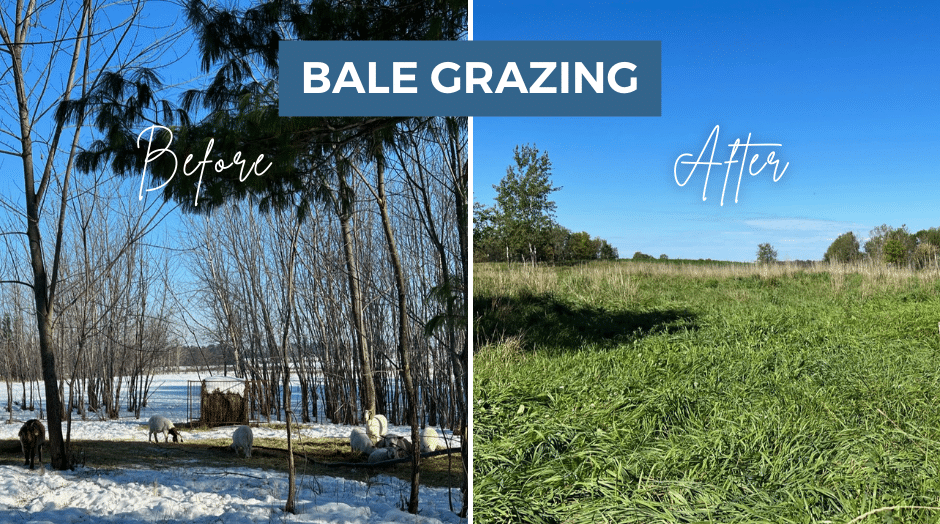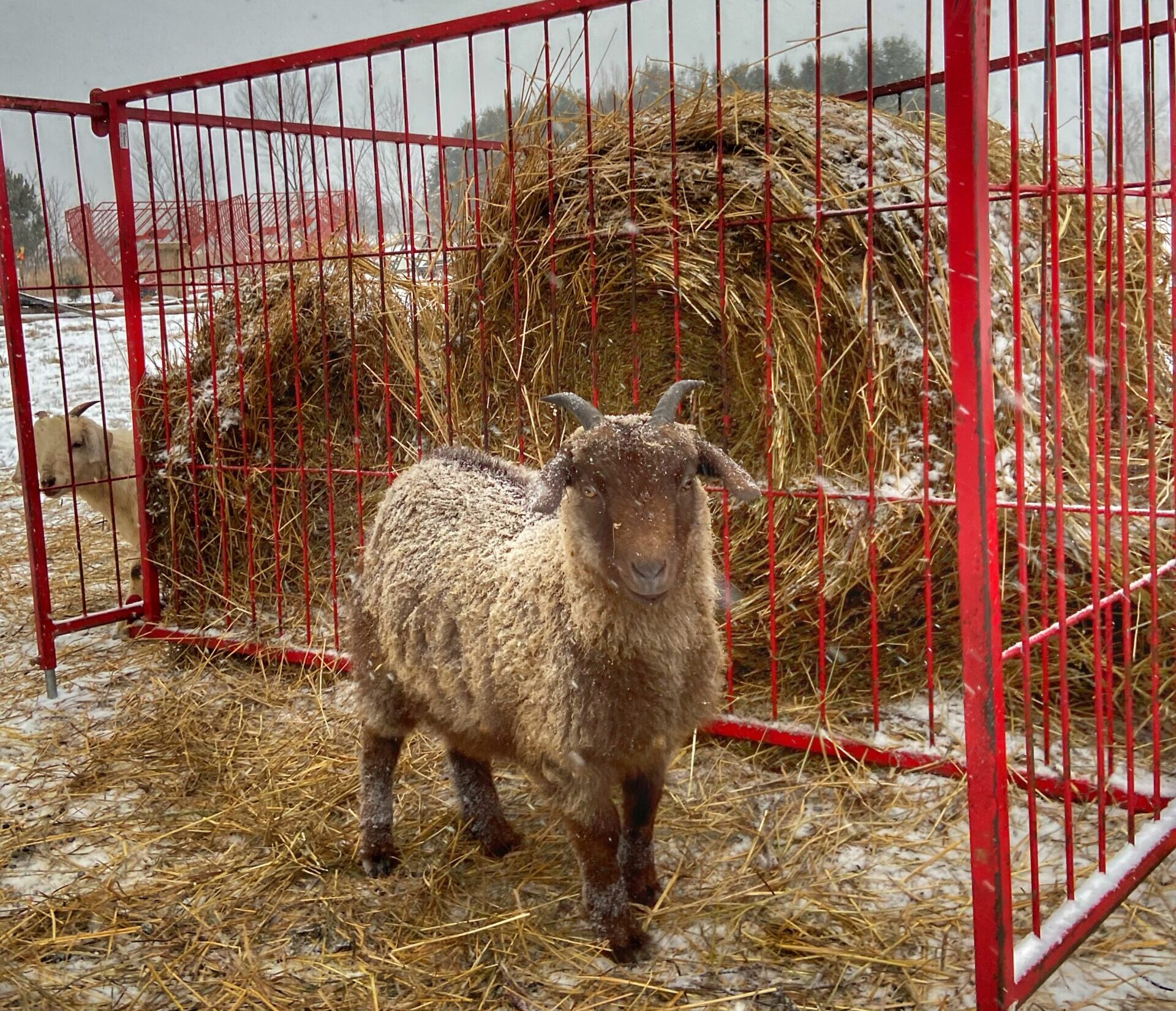When it comes to winter bale feeding your livestock, there are many different approaches you can take, including bale grazing.
Here in Wisconsin we get heavy snowfall during the colder months and as such, we can’t rely on stockpiled forage in our pasture to feed our goats and sheep, though we do all that we can to extend the grazing season each year. Either way, in the winter we switch to feeding hay.
We bale feed our goats and sheep using a practice called bale grazing, where we feed large round bales of hay outside, directly on the ground.
Since we’ve started using this practice many years ago on our farm Cylon Rolling Acres, I’ve continued to be impressed with how quick I can see the results from bale grazing, even with just one season. Later in this article, I talk more about the results, as well as include a video that shows some of my observations during the summer grazing season.
When we started raising meat goats we would feed hay in the barn, but over the years we’ve made some changes to our routine and have seen some major successes as a result — including our own time and benefits for the health of our soil and pastures. I’ll get into this a bit later in the article.
Table of contents
What is bale grazing?
Bale grazing is simply bale feeding hay on a pasture, hay field or even row crop field, during the winter months. Typically hay bales are fed in two ways
- Unrolled all at once, or
- Fed directly from the bale intact
As the bale gets eaten, “waste” is left behind (both from the bale and from the livestock) in the form of organic matter that distributes nutrients to the soil and seeds it for the next season.
Some choose to spread the waste out in the spring for added benefits for the soil or to reduce any thick spots of hay waste though this isn’t always necessary.
Generally, and especially based on the number of livestock (cattle, sheep or goats), multiple bales are placed throughout the pasture in strategic locations, typically in a grid pattern or in areas that need target attention, such has bare ground or poor soil conditions. Additionally, if feeding from an intact bale, multiple bales are used so that each animal is able to access the hay equally and so that you can work to improve as much of the soil underneath as possible.
Bale grazing sheep and goats: techniques
The approach to bale grazing sheep and goats is fairly similar to how one would bale graze cattle. However, there are a few differences that need to be taken into consideration when applying bale grazing techniques.
First, if you haven’t already, you will need to figure how many bales to set out to adequately feed your herd. This calculation diagram is a helpful place to start – just switch out cattle for goats or sheep.
Once you have your numbers figured out you’ll want to consider where to place the bales for feeding, or the bale density. Think of each bale like a concentrated dose of nutrients and target areas of your pasture that could use a boost in forage production.
You’ll also need to decide if you want to use a bale feeder (bale ring) or if you’d prefer to have the bale be free standing for bale grazing.
We use a four-sided collapsible panel style feeder to graze our goats and sheep to avoid excessive hay waste and for safety reasons – as the bale gets eaten down there’s a risk of it collapsing and causing injuries or even lost stock.
You may also consider the use of a feeder as a means to slow eating and further reduce hay waste.
Additionally, since our winter is colder, I’m not as concerned about our hay getting rained on. Snow tends to be drier and sits on the top of the bale. I’m not concerned about the bale getting ruined with moisture.
However, in the spring and late fall when we are bale feeding this approach I will keep our bale in tact with the feeder. The round bale’s outer layer that cured when it was made during harvest, also acts as a protective layer, shedding rain. I still am attentive to watching the quality of the bales I’m feeding during this time period.
We also place round bales as we need them instead of placing them in advance, which is often done with bale grazing cattle.
The reason is that it can be challenging in our colder climate to set up adequate electric fencing to keep our goats and sheep out of the pre-set bales. In our Wisconsin winters we are dealing with frozen ground and snow.
This makes it tougher to put in or take out fence posts, use temporary electric fence, keep the fence adequately energized to keep a hot wire, and also would require us to use multiple strands of polywire, as compared to one strand that is typically used when bale grazing cattle.
This is based on our personal experience. However, I’m always thinking about different ways to approach bale grazing with our goats and sheep to help make it easier to do.
A few fellow small ruminant graziers I know have tried/use these approaches with their herd:
- Use a series of cattle panels and t-posts, set up before the ground freezes. They continually are moving and opening up bales by moving the cattle panels.
- Feeding pre-placed bales that are wrapped in plastic. The plastic is unwrapped as the bales and fed as needed.
Bale Grazing Guide for Goats (and Sheep)
You can also get my bale grazing guide for goats (it still works well for sheep too!) below for more tips on how how to bale feed this way.
Why we don’t use a bale unroller
We prefer to leave our round bales intact for bale grazing instead of using a bale unroller for this reason: manure and urine.
Being that we have goats and sheep, in comparison to larger ruminants like cattle, we have found that the unrolled round bales get pooped and peed on faster than our herd can finish eating them.
Eating hay directly off of the ground, especially for goats and sheep, can increase the risk of gastrointestinal and parasite issues which we aim to avoid.
There are situations where using a round bale unroller for bale feeding could be more beneficial, depending on the context of your farm/ranch and climate.
If you have wet, rainy winters where there’s a lot of mud, unrolling bales may result in less damage to the soil through less hoof action/pounds on the ground.
However, sheep and goats are much smaller livestock than cattle. So it usually would take longer to make an impact as compared to cattle. You can adjust the impact by reducing the number of bales feed through bale grazing.
If you take the approach of unrolling hay and your herd is smaller you can always unroll part of a bale as you need it vs unrolling a full bale at a time to avoid gastro and parasite issues.
Feeders for bale grazing sheep and goats
I like to use a collapsible style bale feeder. These style feeders are easy to move by hand, or you can slide them on the bale spears on your tractor to move multiple panels at once.
I also PREFER having the hay on the ground so you get the BENEFITS of bale grazing and it’s also easier for smaller animals to access the hay. While bale residue or waste a good thing, goats and sheep are notorious for wasting hay. These style feeders also help reduce the hay waste as well.

Advantages of bale grazing
The main advantages we’ve seen in bale grazing has been a marked increase in soil fertility and pasture quality, among other environmental benefits.
In general, bale grazing:
- Increases moisture retention from the addition of organic matter
- Spreads nutrients more thoroughly around the pasture (uniform manure distribution)
- Builds up carbon in the soil for future plant growth and improved soil profile
- Increases plant diversity
- Protects the soil underneath from increased plant density
- Creates fertilizer from manure and urine

In the future I would like to do more analysis of the differences between our bale grazed areas and those not in our pastures on our farm. I’d take a look at soil samples, water infiltration, shovel comparison of soil aggregates and soil temperature.
Other added benefits
Some of the added benefits for you as a farmer is:
- Reduced time and labor spent cleaning the barn since you’re not feeding hay inside
- While it’s not a totally hands off approach, there’s less daily time spent feeding your herd
- Requires less equipment to feed, making it more cost effective
Bale grazing disadvantages
While bale grazing has big benefits, there are some other points to consider before adopting this technique.
In general, some bale grazing disadvantages could include:
- Requires some strategic pre-planning. You’ll want to map out how many bales and bale feeders (should you choose to use them) you’ll need and where they’re going before winter
- Can potentially attract unwanted wildlife, such as deer or elk, especially if you get a lot of snow
- Creates more waste than traditionally found with unrolling or feeding flake by flake
- Requires consideration of the surrounding natural areas. Bale grazing needs to be done away from creeks, rivers, and other water sources to avoid contamination from the concentration of manure and urine
- May need to spread out the hay waste depending how thick it is. If it’s thicker, it may kill off existing pasture. However, we’ve found using a quality bale feeder helps reduce the quantity of waste.
Before and after bale grazing
The impressive thing about bale grazing is that, if done properly, you can visually tell the difference in your pasture. However, for a more in depth look, I recommend soil testing to track your progress. This way you can more accurately fine tune any adjustments you need to make. Your local extension office can help with soil testing.
Here’s what our pastures looked like after a season of bale grazing:

Bale Grazing Video: Results
Here’s a video that shows more on how our sheep and goats are bale grazing and the results we are seeing in just one season of winter bale grazing and the results the following summer — all within one year.
Bale Grazing Video: QA Session
In the Q&A session below answering questions about bale grazing sheep and goats including where you can bale graze in your pasture, how to manage the quality of hay while bale grazing, and how long it takes to see results.
Here is a summary of the Q&A topics I discussed in the YouTube video:
No! You can bale graze anywhere that’s a good fit. We focus on areas of bare soil that are somewhat wispy and need extra nutrient support so that we can create optimal soil health.
Bale grazing in these areas helps to build up an armor to maintain temperature (especially in the winter), help with soil erosion, and foster the development of soil microbes underground while there are living plants on top.
n general, it only takes one season. In our case, since we’re bale grazing this winter over bare soil and essentially starting from scratch, it will likely take us a bit longer to see results.
In other areas of our pasture we have seen almost immediate results just by looking at water infiltration ability and then the more obvious signs of green growth.
In most cases we will have our sheep and goats eat the residue. Once the bales get down to a certain size we’ll take the feeders off and they’ll continue to eat the bale down, residue included.
If what remains is particularly thick we’ll take the tractor bucket and spread it out so that it doesn’t overwhelm one particular spot in the pasture with growth.
Our sheep and goats have access to our main barn with nearby frost-free waterers, we just like to feed them out in the pasture so that they get extra exercise going back and forth.
The sheep tend to be hardier in that they don’t mind being outside as much as the goats, but the goats are happy to spend time away from the barn on sunnier days, even if it’s chilly out.
Each section of pasture has three-sided shelters and frost-free waterers so that there are areas where they can stay dry, get out of the wind, and stay hydrated when and if they need it.
Here in Wisconsin, when it gets cold enough, it actually stays pretty dry so even when there’s snow, the top of the bale will hold the snow and prevent it from soaking in and spoiling the rest.
One of things that we do to manage the quality of the hay outside, especially when rain is in the picture, is consider the positioning of the bales. We place rolled bales on their side because then the water will shed off to the sides instead of pooling on top and soaking in.
Because we store our bales outside, there’s naturally a layer on top that isn’t as good of quality as what’s on the inside but that’s part of the curing process of having round bales and when you store them outside.
That same outer layer protects the hay inside. We also leave the twine on to maintain the integrity of the bale and cut pieces as the sheep and goats eat the bale down.
We like these particular bale feeders because they have a narrow opening where the sheep and goats can easily stick their noses in to eat but they can’t pull out big chunks of hay, which means much less hay waste!
Learn more about these hay feeders here.
We don’t have a harrow right now, but we’ll use the bucket tractor to spread the residue around if it’s particularly thick and the sheep and goats aren’t able to clean it all up.
Bale grazing, when done on the ground (and not in a raised feeder) does have the potential to increase parasite issues with goats and sheep.
It’s also important to consider the time of year you plan to bale graze. During the winter parasite loads are greatly reduced, as compared to when it warms up in the spring and the transition into fall.
Related Resources: Articles and podcasts
Here are some of my favorite articles and podcasts relating to bale grazing:
Articles
- gov.mb.ca – The Basics and Benefits of Bale Grazing
- UGA Forage Extension Team – Bale Grazing 101
- Beef Cattle Research Council – Bale Feeding Options: Pros and Cons of Common Strategies
- Steve Kenyon – The Economics Behind Bale Grazing
Podcasts
- Working Cows – Episode 5 – Paul Jungnitsch, Bale Grazing
- Working Cows – Episode 68 – Steve Kenyon, Managing Waste in Bale Grazing
- Field Notes – Episode 3 – Bale Grazing
Originally published: October 2022. Updated January 2024.

LEAVE A COMMENT
Comments